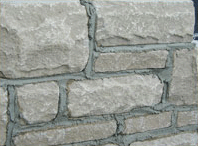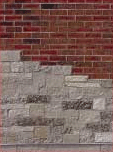Increasing Bond Strength with Polymer-modified Stone Veneer Mortar
By Masonry
"Common sense is the knack of seeing things as they are, and doing things as they ought to be done."
- Harriet Beecher Stowe
 Common sense tells us that any methods used to enhance the bond between stone veneer units, stone veneer mortar and the substrate are beneficial. When it comes to stone veneer mortar, the important fundamental properties are workability, water retention and bond strength. Using a moisture retention aid, such as lime or cellulose ether, can enhance the stone veneer mortar's mechanical bond by retaining moisture and thereby allowing more paste to be drawn into void spaces and pores within the substrate surface.
Common sense tells us that any methods used to enhance the bond between stone veneer units, stone veneer mortar and the substrate are beneficial. When it comes to stone veneer mortar, the important fundamental properties are workability, water retention and bond strength. Using a moisture retention aid, such as lime or cellulose ether, can enhance the stone veneer mortar's mechanical bond by retaining moisture and thereby allowing more paste to be drawn into void spaces and pores within the substrate surface.
When designed properly, stone veneer mortar (SVM) can provide an excellent bond. However, various job site factors can adversely affect the bonding ability of ordinary stone veneer mortar. Factors affecting bond can include, but are not limited to, improper or inadequate substrate preparation, material incompatibilities, presence of bond-breakers, weather conditions and application methods.
Incorporating a polymer into the dry, pre-blended SVM can significantly enhance the bond between the SVM to both substrate and the stone veneer unit. A polymer-modified SVM is less sensitive to substrate compatibility issues than a SVM without polymer.
Polymer-modified SVM can be achieved in several ways. These include adding to mixtures of portland cement, lime and sand:
- a job site-added liquid acrylic,
- a job site-added liquid vinyl acetate ethylene,
- a liquid styrene butadiene rubber (SBR) latex as a replacement for all or part of the mix water,
- a redispersible vinyl acetate ethylene (VAc/E) powder added to the dry pre-blended mix or other different base polymers in combination with VAc, or
- a redispersible acrylic powder added to the dry pre-blended mix.
 Redispersible polymers are often misunderstood. The confusion stems primarily from the word "redispersible" in that it is often thought that redispersible powders will redisperse and migrate out of the hardened mortar or concrete with each exposure to moisture. Redispersible powders are manufactured by spray-drying polymer dispersions. Prior to spray-drying, a water-soluble colloid typically is added to the aqueous dispersion to aid in redispersion. During the spray-drying process an anti-caking agent is added to prevent agglomeration. The solid polymer particles merge into larger polymer particle conglomerates. When these larger particle conglomerates come in contact with water, they redisperse and adjacent polymer particles combine to form a dense film. Once the film is formed, the polymer particles no longer are able to redisperse with further contact with water.
Redispersible polymers are often misunderstood. The confusion stems primarily from the word "redispersible" in that it is often thought that redispersible powders will redisperse and migrate out of the hardened mortar or concrete with each exposure to moisture. Redispersible powders are manufactured by spray-drying polymer dispersions. Prior to spray-drying, a water-soluble colloid typically is added to the aqueous dispersion to aid in redispersion. During the spray-drying process an anti-caking agent is added to prevent agglomeration. The solid polymer particles merge into larger polymer particle conglomerates. When these larger particle conglomerates come in contact with water, they redisperse and adjacent polymer particles combine to form a dense film. Once the film is formed, the polymer particles no longer are able to redisperse with further contact with water.
With the growing popularity of stone veneer wall systems, it makes sense to move toward this new technology to enhance the properties of stone veneer mortar.
About the Author
Masonry, the official publication of the Mason Contractors Association of America, covers every aspect of the mason contractor profession - equipment and techniques, building codes and standards, business planning, promoting your business, legal issues and more. Read or subscribe to Masonry magazine at www.masonrymagazine.com.


















